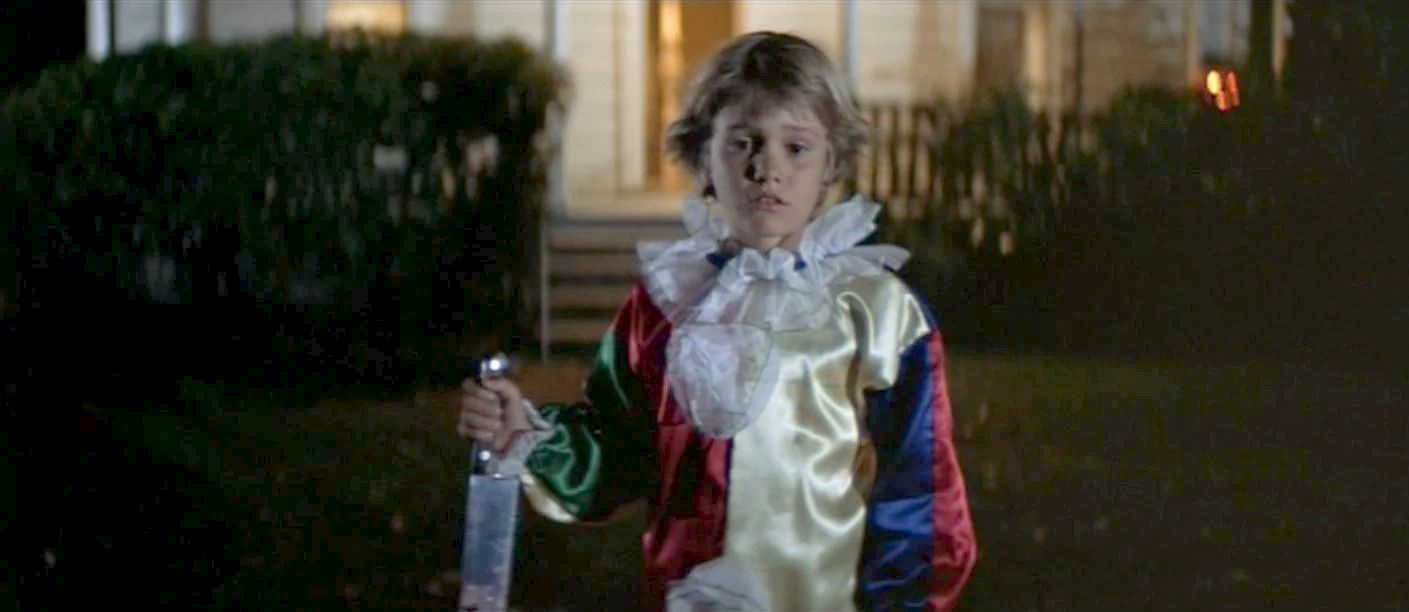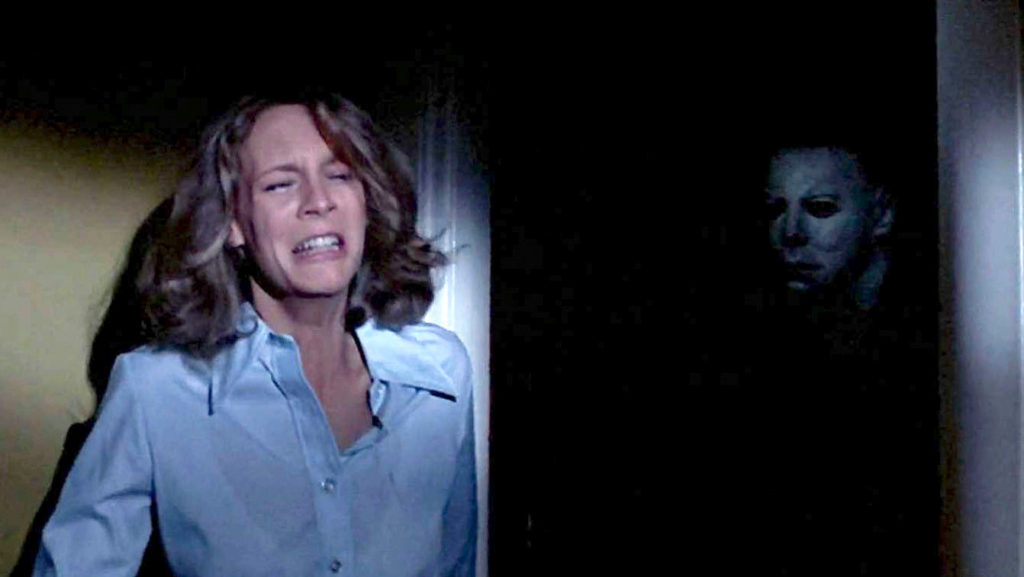Horror remakes, by and large, suck. The vast majority of them are nothing but cheap cash-ins: the common approach seems to be to tone them down to PG-13 level, stuff them full of actors from television soap-operas, and send them to the theatres without previewing them for critics, in the hope of making your money back over the first weekend [because you know the box-office is going to tank thereafter]. The vast majority manage to forget what it was that made the originals successful, and fail to bring anything new to the party – as a result, the product which ensues, generally fails, both on its own terms and in comparison to the original.
Remaking Halloween seemed to teeter on blasphemy. Almost universally regarded as one of the best horror films of all time, its simple tale of escaped lunatic Michael Myers, returning ‘home’ to continue his killing spree on Halloween night, is among the most influential of all genre movies. However, I was intrigued, in that the person charged with helming the remake was Rob Zombie – someone who actually does possess more of a horror pedigree than the usual suspects in such cases [hello, Gus Van Sant!]. While I haven’t been an enormous fan of Zombie’s work to date, there’s no denying his love for the genre. But could that be translated successfully into a remake of such a classic? Would the benefit of telling the story in a modern setting be enough to offset the familiarity of the material? We sat down and watched the two, back-to-back. Here’s the results.

Halloween (1978)
Rating: B-
Dir: John Carpenter
Star: Jamie Lee Curtis, Donald Pleasence, Nancy Loomis, P.J. Soles
The problem, I find, with watching Halloween from a modern perspective, is its template has been copied by, literally, hundreds of movies since – good, bad and (mostly) indifferent. Inevitably, this leaves you feeling jaded about the original. It’s like going to Salzburg and seeing Mozart plastered over tea-towels, chocolate boxes and T-shirts. Makes it easy to forget, he wrote some damn good tunes. The same goes here. Horny teens, smoking weed, drinking, and being slaughtered for their sins, by an unstoppable, masked killer? All such a horror dead horse now, it’s impossible to imagine a point where this was a novel concept. No matter how well-executed – and there are few complaints on that score, pun not intended – it can’t help feeling like a procession of tropes.
At the time, however? The film certainly owes a debt to Black Christmas, not least by opening with a scene from the killer’s point of view. Though Halloween was actually made on a considerably smaller budget, around half the cost of its predecessor. Carpenter received a mere $10,000 for writing, directing and composing the score to the film, which seems remarkably good value for money. However, he did also get 10% of the profits. Considering Halloween grossed $60-70 million, around two hundred times the budget, seems safe to say Carpenter did not find himself short of a sandwich from this agreement. On the other hand, if what I’ve heard of Hollywood accounting is true, the movie may not yet officially be in the black.
 The lack of money did certainly affect the film. Rather than Pleasence, the original choice for Dr. Loomis was Peter Cushing, and while Pleasence is good, I can’t help thinking Cushing would have been wonderful. However, his agent declined the salary as too low. It’s not clear how much he was offered, but Pleasence did it for $20,000; in the agent’s defense, his client was just coming off a significant role in a little film called Star Wars. Another good choice, Christoper Lee, also turned the part down, though regretted doing so. Another key player, Nick Castle, who played the masked killer, called “The Shape” in the credits, received just $25 a day. He went on to find greater recognition as a director, with films including The Last Starfighter and Dennis the Menace.
The lack of money did certainly affect the film. Rather than Pleasence, the original choice for Dr. Loomis was Peter Cushing, and while Pleasence is good, I can’t help thinking Cushing would have been wonderful. However, his agent declined the salary as too low. It’s not clear how much he was offered, but Pleasence did it for $20,000; in the agent’s defense, his client was just coming off a significant role in a little film called Star Wars. Another good choice, Christoper Lee, also turned the part down, though regretted doing so. Another key player, Nick Castle, who played the masked killer, called “The Shape” in the credits, received just $25 a day. He went on to find greater recognition as a director, with films including The Last Starfighter and Dennis the Menace.
What stood out for me on this viewing is how curious car-centric it is in the early going, with Michael Myers cruising around the Haddonville neighbourhood in a stolen vehicle. I was distracted by the question of how he learned to drive, having been cooped up in an asylum since he was six. The film does at least acknowledge the question, Loomis spitting at asylum colleague Dr. Wynn, “Maybe someone around here gave him lessons!” It plays almost like a public information film, about the dangers of accepting lifts from strangers in cars: they certainly don’t come much stranger than Michael Myers. I’m almost disappointed when he parks up and continues on foot; the idea of a fully committed auto-slasher remains unfulfilled (I guess Christine?).
It’s likely a toss-up between this and Night of the Living Dead as to which has been the most influential movie in horror history. The sheer number of films to take inspiration from them can hardly be counted. Like Night, most of the descendants of Halloween don’t come up to the same level, here particularly in the areas of characterization and camerawork. Now, these aren’t areas particularly required for horror, to put it mildly. However, they are what help lift genre entries to the level where even those outside fandom can admit to its qualities. It’s all the more impressive that Carpenter manages to do this, without abandoning the more visceral elements: make no mistake, this is not “elevated horror” or any such guff. Part of its strength is its purity. “It was the boogeyman!” sobs Laurie at the end. “As a matter of fact, it was,” replies Loomis. Horror stories do not get much more simple than that.
This article is part of our October 2022 feature, 31 Days of Classic Horror.
 [May 2009] Thirty years have now passed since Carpenter’s seminal slasher pic. How has it stood up to the test of time? The answer is, surprisingly well, though certain aspects have become so familiar, to the point of cliché. For example, the maniac who suddenly comes back to life, when you think they’ve been killed, is now such a part of horror-movie culture, it causes rolling of eyes. One can only speculate what kind of an impact it had, three decades previously, to an audience not used to such things.
[May 2009] Thirty years have now passed since Carpenter’s seminal slasher pic. How has it stood up to the test of time? The answer is, surprisingly well, though certain aspects have become so familiar, to the point of cliché. For example, the maniac who suddenly comes back to life, when you think they’ve been killed, is now such a part of horror-movie culture, it causes rolling of eyes. One can only speculate what kind of an impact it had, three decades previously, to an audience not used to such things.
There are a couple of things which have lasted particularly well: the soundtrack, which adds an enormous level of menace, to things as simple as heroine Laurie Strode (Curtis) going to school, and the performances, especially from Curtis, in her feature debut, and Pleasence, as psychiatrist Dr. Loomis – though both have had long, successful careers, it’s this film which remains their most recognizable, and for good reason. It’s been a very long time since I’d seen this in its entirety, probably twenty years or more, and so much of it had slipped my memory, especially in the middle. I was surprised at how long it takes to get going – after the opening, it’s probably an hour before there is another on-screen death, a languid pacing which could have a modern audience shifting in their seats with boredom.
I can’t say it bothered me too much, however: I found things to keep me amused, such as the frequent footage on TV of The Thing – which, of course, Carpenter would go on to remake himself, to great success, a few years later. Of course, it’s made easier by the knowledge that things will eventually kick into gear. When they do, it’s still prime-quality suspense and terror, enhanced [and this is where so many remakes, and indeed horror movies in general, go wrong] by the fact that you do care about the character in peril. While chunks are now too familiar, through frequent repetition, its place in the horror Hall of Fame is fully justified. B.
Halloween (2007)
Rating: B-
Dir: Rob Zombie
Star: Scout Taylor-Compton, Malcolm McDowell, Tyler Mane, Sheri Moon Zombie
The key difference is that much more focus here is put on Michael Myers. We get his backstory, including his hellishly dysfunctional family, and Myers’ fondness for torturing animals. After he has killed his mother, father and elder sister [rather than just the last-named], there are scenes in the asylum as Loomis (McDowell) tries to pry open his mind, and the suicide of his mother after he kills a nurse. This all combines to round out his character; the original started with his first murder, and little or no explanation for why he is “purely and simply evil”. Here, he is almost sympathetically-portrayed, and that is something of a double-edged sword. While it does give Zombie the chance to develop the remake into its most interesting areas, they make it harder to agree when Laurie says, “It was the boogeyman,” since Myers is depicted more as a textbook psychopath than a semi-supernatural entity.
Credit to Zombie for keeping a lot of the original dialogue and, I’m pleased to say, the music, which works every bit as well here as in the original. I was also impressed by the beautifully self-referential choice of a Michael Myers mask as the one of choice by… Michael Myers [though I was hoping he’d pick up and try on a hockey-mask, before throwing it away in disgust]. However, for all his attributes, McDowell is no Pleasence, and Taylor-Compton definitely no Curtis: as a result, the extended stalk-and-slash into which the film heads is significantly less effective – as in Zombie’s previous films, he goes on longer than needed for best effect. I’m curious about the appearance of Udo Kier in what only amounts to a brief cameo, and imagine there were additional scenes featuring him that ended up cut out, perhaps for reasons of pacing, and that aspect is generally better here. All told, it’s definitely a cut above the average horror remake, and would stand well enough on its own. Watched immediately after the original, however, it would take a brave man to claim it was as good. I am not that man.
